How to grow kohlrabi – all you need to know about the quirky turnip cabbage
Find out how to grow kohlrabi for a cool-season vegetable that delivers crunchy goodness in summer, fall and winter
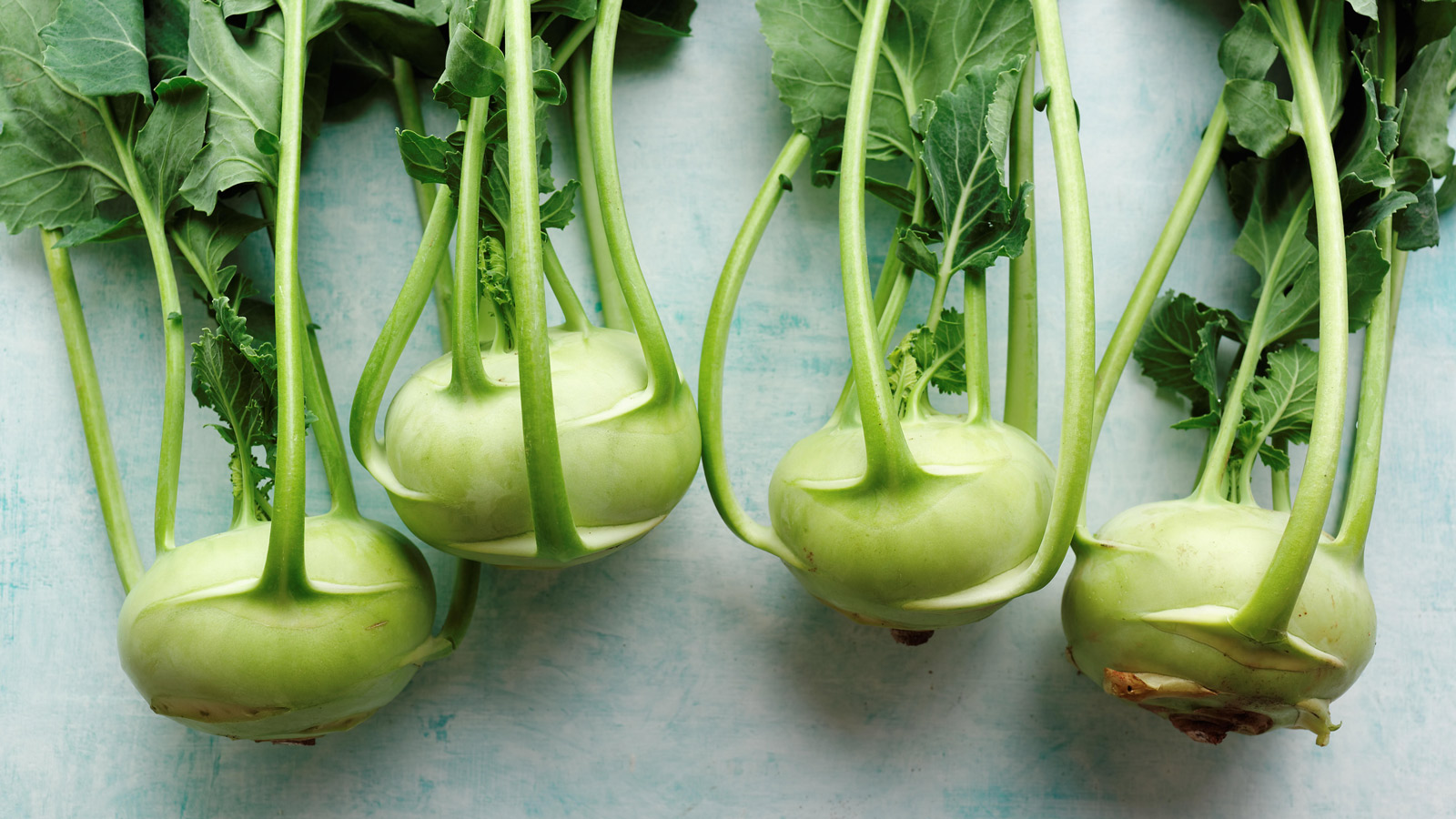

Learning how to grow kohlrabi introduces you to one of the most visually intriguing vegetables you can cultivate. Looking a little bit like an alien from a horror movie, kohlrabi (which is German for ‘turnip cabbage’) is a fascinating crop.
Like a cross between a broccoli, a turnip and an apple, the quirky kohlrabi (Brassica oleracea var. gongylodes) grows long leafy limbs draped around a swollen stem. These swollen stems (confusingly called ‘bulbs’) develop quickly above ground with minimum fuss. And because these brassicas are cool-season crops, they are a perfect choice for starting on the plot both early in the year and later in the season.
Crisp and crunchy, kohlrabi is rich in vitamin C and A, potassium, iron and calcium, and both stems and greens can be enjoyed. It’s great for boosting bone density, regulating blood pressure and improving eye health, and adds a peppery freshness to salads and stir-fries. As well as being frost-friendly, it is more drought-resistant and resilient than other brassicas and, depending on which varieties you grow, can crop from summer through to winter. So if you fancy adding a taste of adventure to your vegetable garden ideas, why not try one of the hardiest vegetables around?
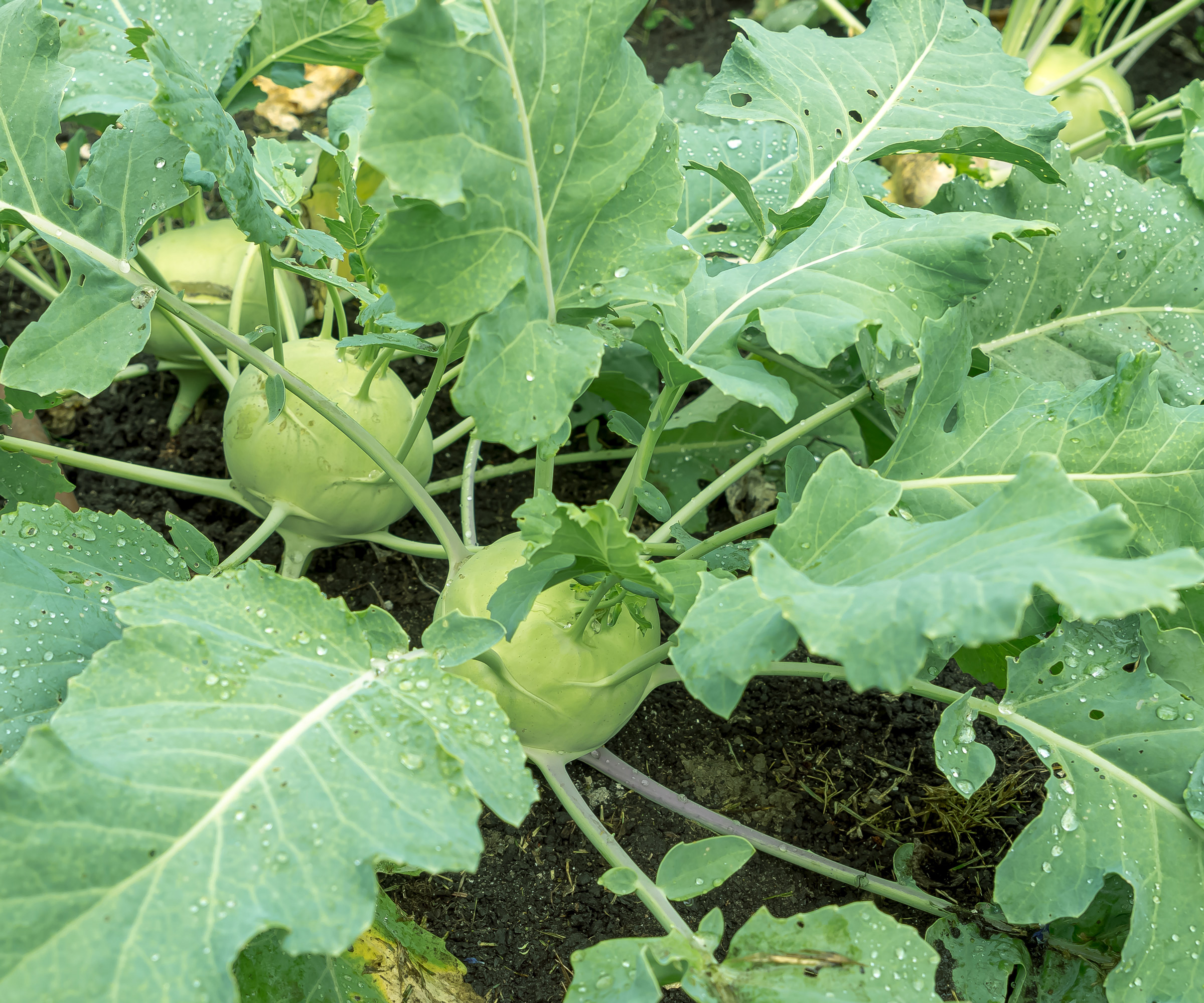
Kohlrabi is a cool-season crop and makes the most of colder points in the gardening calendar

Janey has been assistant editor of Amateur Gardening magazine for five years. She has taken an active role in a series of conservation, urban renewal and rewilding projects for the RHS and TCV. She has been gardening from an early age, when her mum had her deadheading hydrangeas, mulching roses and propagating strawberry plants from runners for school open days. Here she explains how to get started with kohlrabi and the steps you need to take to cultivate healthy crops.
Ideal conditions to grow kohrabi
The main components for successfully growing kohlrabi are sunshine, frequent hydration and space. In the main, these crops are some of the easiest vegetables to grow and you won’t need to do much in the way of soil preparation. But the right spot is one that gives your emerging crops at least six hours of sunshine a day, plus a moist, well-draining soil with a top-dressing of compost or similar well-rotted organic material. While kohlrabi can cope with most types of soil except waterlogged and parched, it prefers soil with a pH of 6-7. Growing in a raised bed can help with drainage, as long as there is ample depth for roots.
Kohlrabi are not fussy growers and don’t come with a long list of demands. However, Nancy Awot-Traut, horticulture specialist at Burpee Gardening, advises caution if planting where you previously grew cabbages or cauliflowers, as this might expose your crops to nutrient deficiencies. ‘Don’t plant in the same place you planted anything from the brassica family for at least two years,’ says Nancy. Other than that, these plants are easygoing. Lovers of companion planting will find that these crops flourish alongside cucumbers, beetroot, chives and onions.
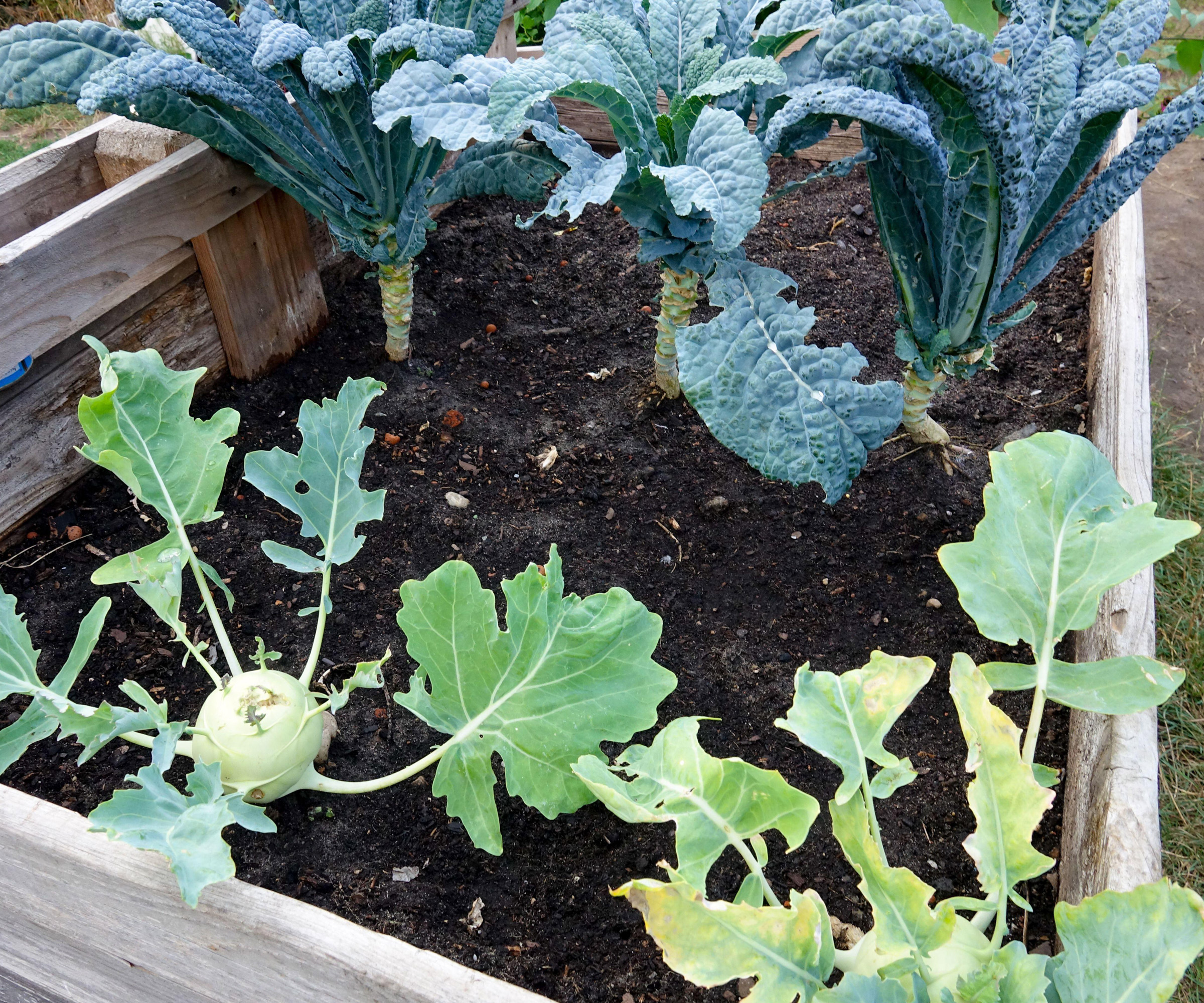
Raised beds make excellent planting sites for kohlrabi as long as the earth is deep and well-drained
When and how to grow kohlrabi
Kohlrabi can be started off in spring and summer, depending on the variety. Just remember these are cool-season crops and appreciate time to establish and mature when there is less risk of exposure to extremes of heat. However, as Amateur Gardening’s organic expert Bob Flowerdew points out, kohlrabi do enjoy an early phase of warmth (under glass if started in spring) before ripening in cooler conditions. Conversely, while these hardy crops taste better after being exposed to a light frost, it is wise to cover developing plants with a blanket, polytunnel or cold frame to protect from frost if extreme cold snaps are anticipated.
If starting in spring, you can sow outdoors as long as the ground isn’t frozen (aim for 45˚F or higher). If you are sowing indoors, just make sure you can plant out so that crops can take full advantage of cooler spring weather before things heat up. Alternatively, sow in summer so crops are in the ground and flourishing by the time cooler fall weeks roll around. Depending on where you live and the varieties you choose, you can sow any time between February and August. These plants do well in USDA hardiness zones 3-9 and thrive in temperatures between 60-70˚F.
There are two main types of kohlrabi: green and purple. Green varieties tend to be best sown in spring, while those keen on purple plants should sow in high summer. The purple varieties are the hardiest and can potentially be harvested right up until winter if treated with care. Some of the best ‘early’ varieties include ‘Viennese Early White’, ‘Olivia’, ‘Korist’, ‘Korfu’ and ‘Grand Duke’, whereas those after fall harvests should consider ‘Purple Vienna’, ‘Gigante’, ‘Kolibri’ and ‘SuperSchmelz’.
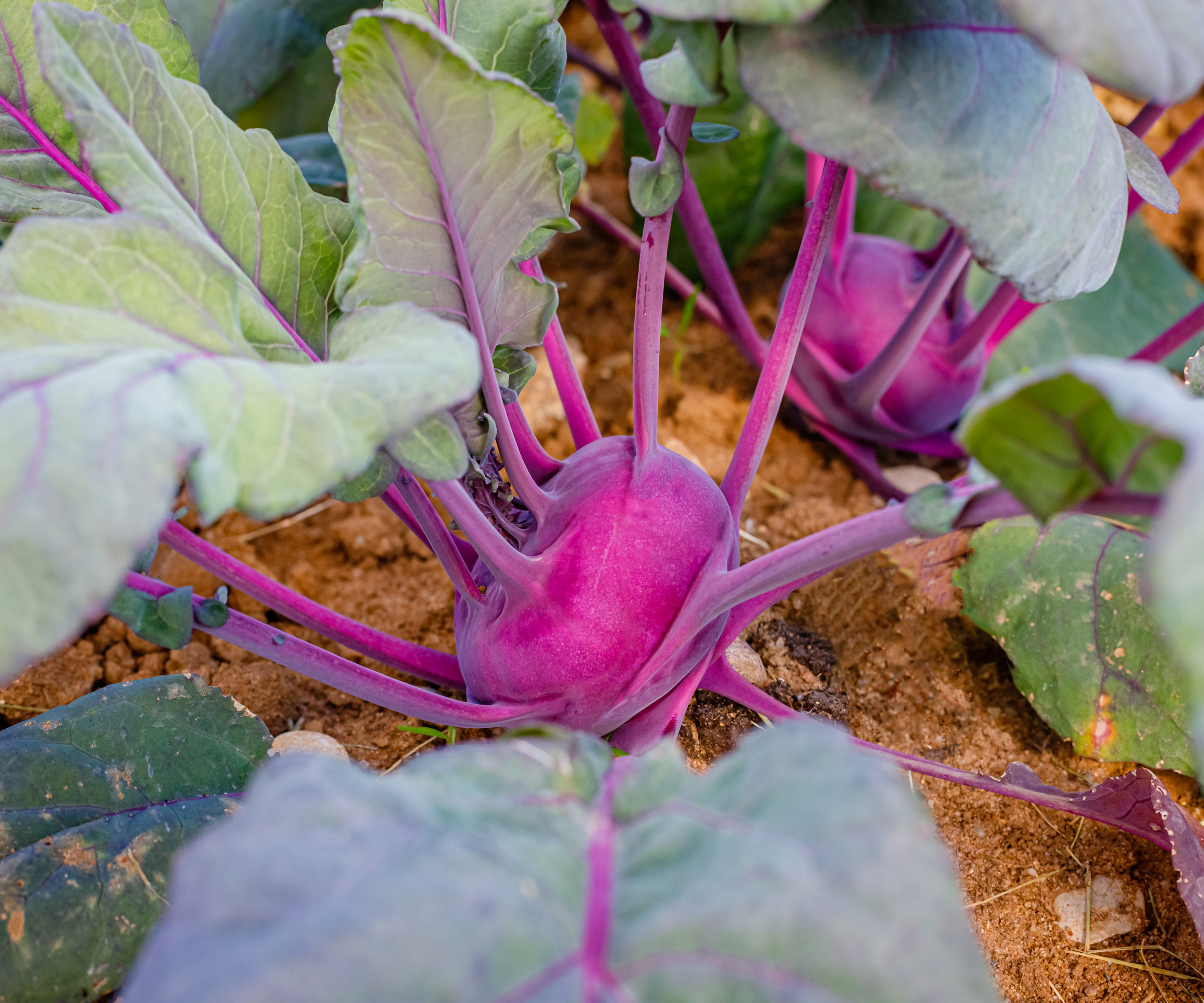
Several varieties of kohlrabi are purple, such as ‘Purple Vienna’, ‘Purple Danube’ and ‘Kolibri’
How to plant kohlrabi from seed
Growing kohlrabi from seed is straightforward. You can start them off outside and indoors. Either way, treat the earth with compost or aged organic material, plus a little fish, blood and bone, about three weeks prior to planting.
Whether you start indoors or outside (direct) will be determined by variety, when you wish to harvest, and the likelihood of weather extremes disrupting growth. However, as Amateur Gardening’s veg expert Lucy Chamberlain indicates, it’s possible to enjoy crunchy harvests even if the weather is less predictable, if you adhere to a few key principles.
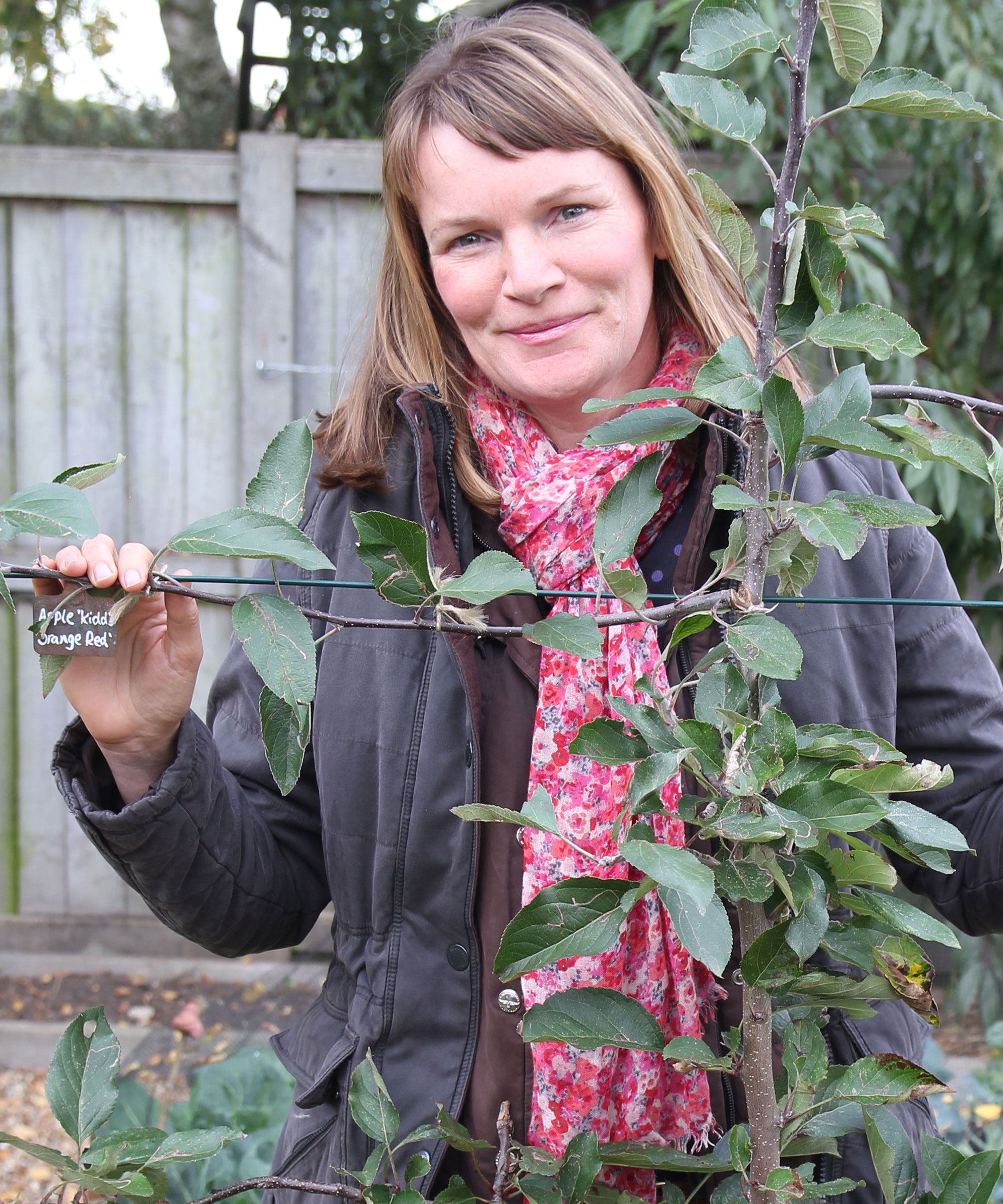
Lucy was a Horticultural Advisor at RHS Wisley and has been Head Gardener on a 100-acre estate in England for many years, but writes regularly for titles such as The Garden, Gardeners’ World, The Guardian and Amateur Gardening. She’s also the author of RHS Step by Step Veg Patch, available from Amazon, which covers 50 types of fruit and veg.
Avoid the basic seed sowing mistakes and follow her guidelines for kohlrabi:
- If starting indoors, sow in modules of moist compost, placing two seeds per cell. Germination should take place within 10-14 days of sowing.
- Allow four weeks before hardening off and transplanting to final positions. Seedlings are ready to be planted out when they are 2in tall.
- If sowing direct, sow in drills half an inch deep. Make sure the earth is moist and sow thinly (with seeds placed at roughly 2in intervals). Cover with a light dusting of soil and water in.
- For outdoor sowings, cover with a polytunnel, cold frame or cloche, depending on the likelihood of hard frost. Covering with netting or horticultural fleece can also defend against pests like cabbage root fly.
- Thin outdoor sowings once you spot the first pair of true leaves, making sure the remaining plants are spaced 8-12in apart.
- Make successive sowings every three weeks from March to August to guarantee an extended season of harvests right through to winter.
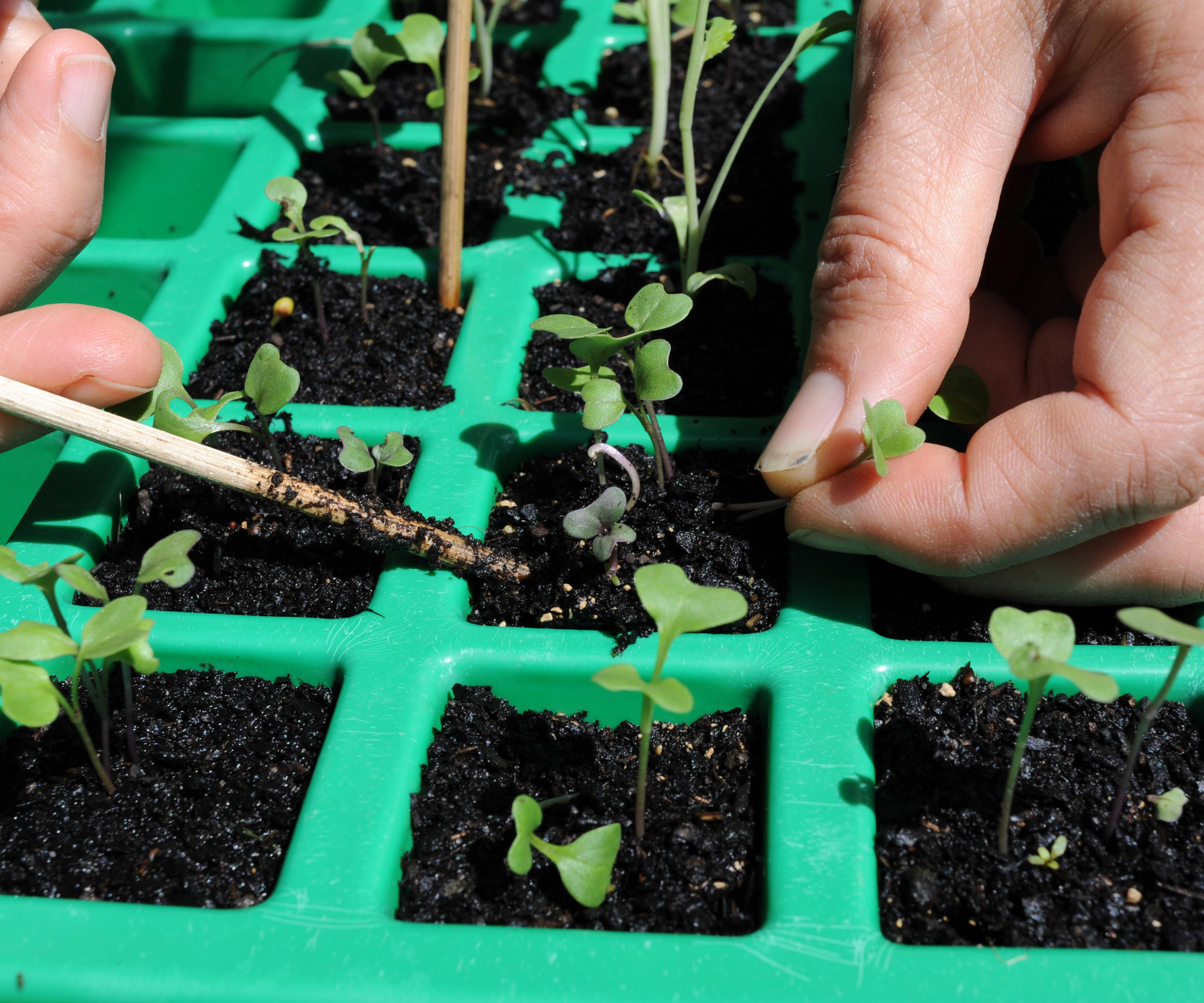
Thin out your kohlrabi seedlings as the first true leaves appear, and make sure at planting that they are well spaced
How to grow kohlrabi in containers
If you want to grow kohlrabi in containers, you can. The main factors with container gardening are the same as those with ground planting: light, moisture and space. The more space you can allow around each plant, the better. For this reason, it’s best to select the biggest container possible, at least when potting on crops to their final positions; consider troughs, outdoor planters or five gallon buckets with drainage holes added. Depth of container is critical as you need to allow ample room for root development (find something at least 15in deep and across).
Bear in mind that if you use unglazed clay or terracotta, pots will dry out quicker than plastic and you’ll need to water the plants more frequently. Keep a watchful eye on moisture levels, and make sure compost is never allowed to get parched. Kohlrabi is drought-tolerant, but extended bouts of dehydration will impact stem quality and flavor. Keep containers on a sunny balcony or patio, but factor in partial shade on hot days. A light mulch of wood chips, moss or grass clippings can help retain moisture.
Thin container-based seedlings as you would for standard plantings, and make sure established kohlrabi are limited to one per pot for the best chances of successful cultivation. Also, select varieties with the quickest maturing times. Some of the best for container-based growing include ‘Grand Duke’ and ‘Kolibri’, which both mature in around 50 days, and ‘Konan’, which can be harvested as soon as 45 days after planting.
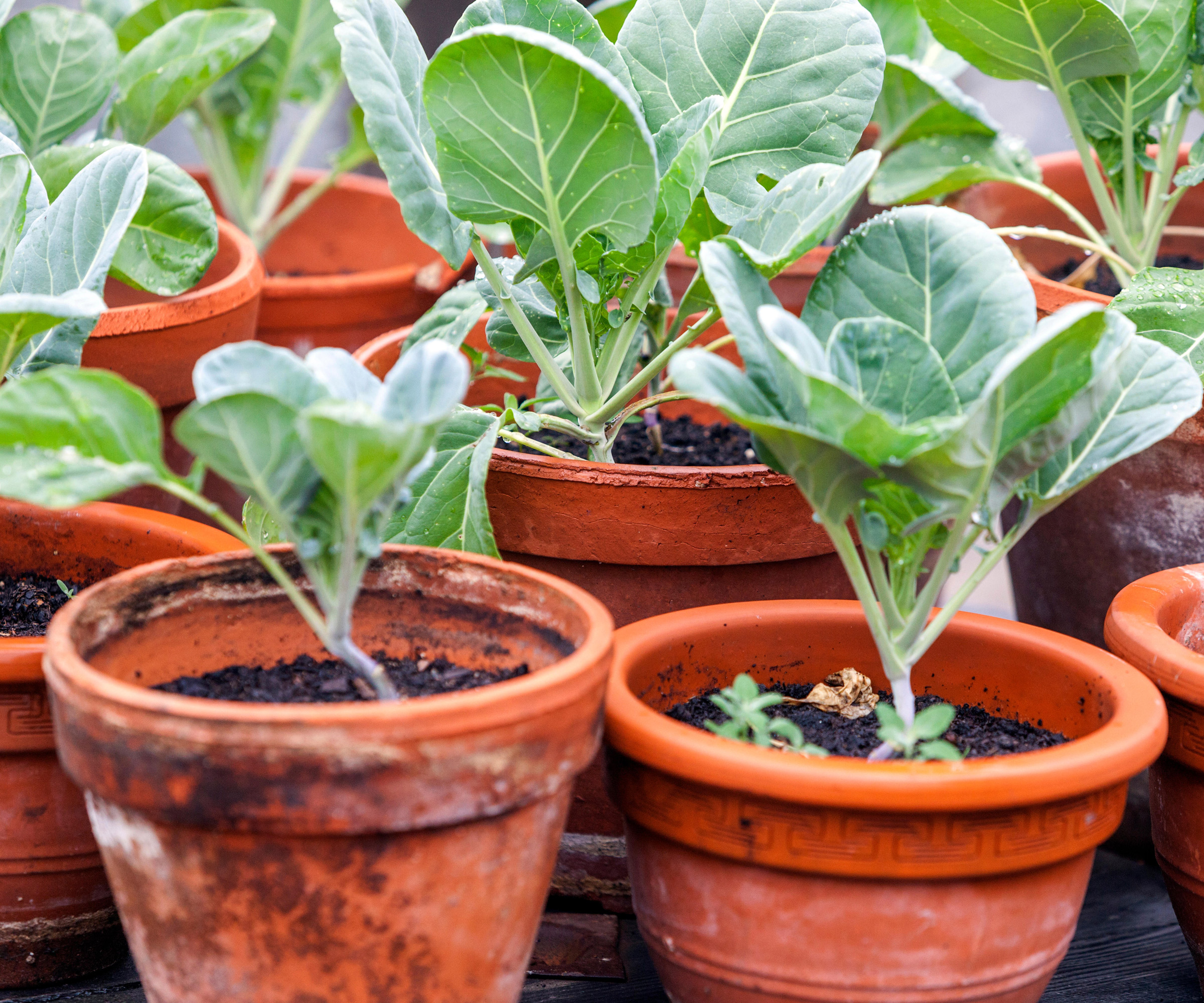
You can easily start kohlrabi off in pots but if you intend to keep them in containers, make sure they are deep and well nourished
Caring for kohlrabi
Once you know how to grow kohlrabi, these plants are pretty simple to look after. Your main consideration is to water plants frequently during the growing season. According to Nancy Awot-Traut, kohlrabi needs an inch of rain a week. It’s important to maintain balanced moisture levels so that emerging crops don’t dry out and become woody and bitter. Give plants a good mulching with straw, grass clippings or wood chips to ensure that moisture levels don’t dip. This can also help with humidity levels, particularly on warm days. Liquid feed applied every three or four weeks will stimulate leaf growth. You might also like to top up compost levels at monthly intervals to give plants a nitrogen boost.
Another main consideration is to keep an eye on developing weeds. Aim to get rid of weeds as soon as you spot them, and while they are still young, small and relatively easy to dislodge; be sure to remove weeds by hand. However, take care not to disturb the root systems of young plants. When growing kohlrabi, the only other thing to keep an eye on are the spacings between plants. If you have thinned and planted out correctly, this shouldn’t be an issue, but if things start to look crowded, take steps to rectify it as quickly as you can, so cropping plants are about 12in apart.
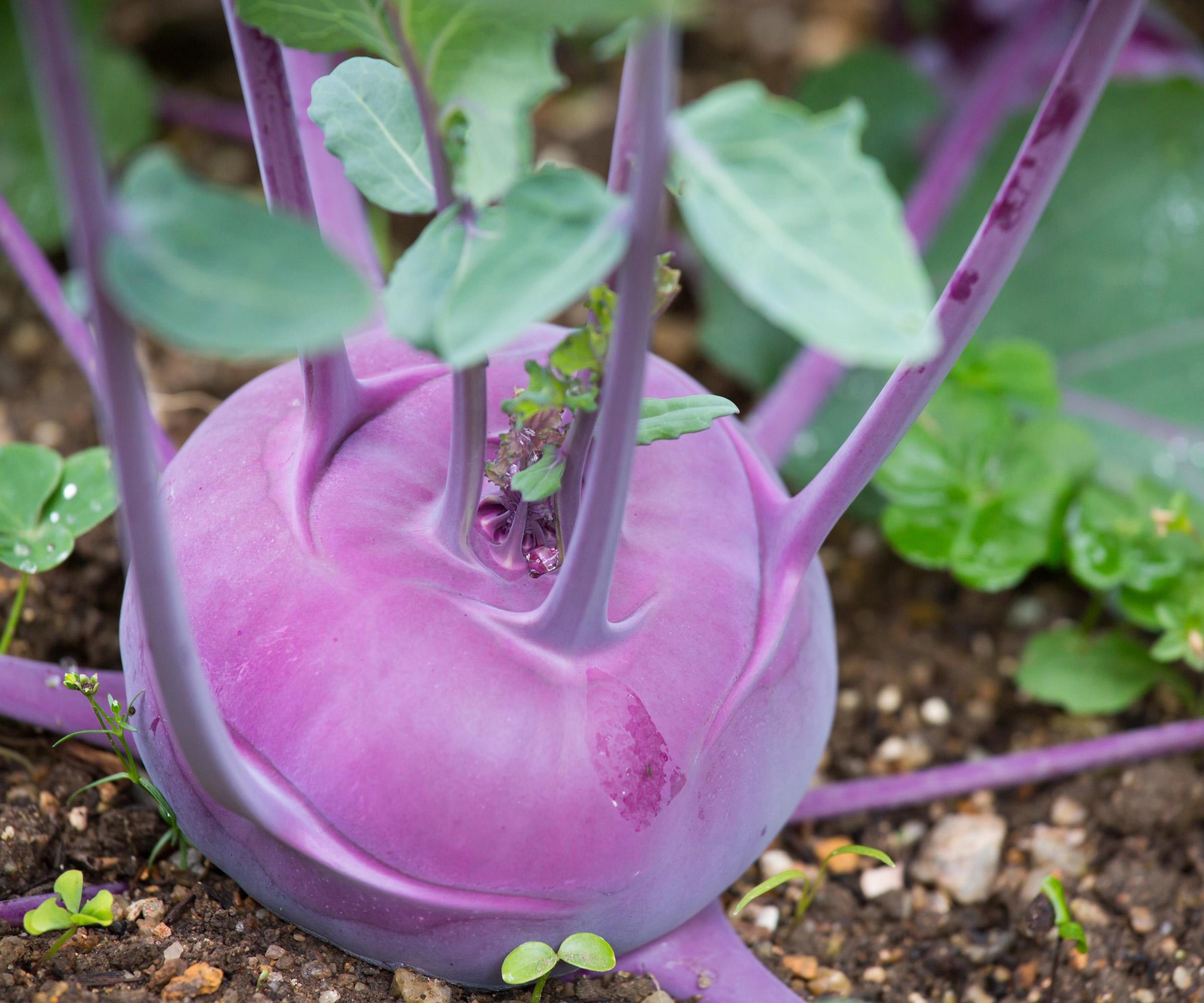
Be diligent about any emerging weeds but take care not to disturb the roots of developing crops
Problems growing kohlrabi and how to solve them
It’s true that growing kohlrabi does involve a few of the same risks as any of the brassicas, but if you are careful you won’t sacrifice plant quality or yield. In fact, kohlrabi tends to be less affected than other brassicas such as cabbage. There are a number of pests and diseases to anticipate, but if you take preventative measures, you can minimize some of the risks. A few pests, such as slugs, may be inevitable, but you can get rid of snails and others if you take action swiftly. Here are some of the main problems:
- Clubroot: The classic brassica foe. Check for stunted foliage and swollen roots. Make sure soil is alkaline (by adding lime) to alleviate this, and check that soil has good drainage: raised beds can also help.
- Aphids: Look out for yellow, distorted, sticky or fallen leaves. You can get rid of aphids by introducing companion plants like nasturtiums and beneficial predators like lacewings or spraying soapy water on leaves.
- Cabbage worms: You may see green caterpillars, foliage with large, or yellow eggs. Handpick pests and remove damaged leaves. Prevent with horticultural mesh, and tackle with organic insecticides.
- Powdery mildew: The tell-tale sign is a flour-like covering that dusts foliage. Reduce the risk of powdery mildew with good airflow between plants and choose disease-resistant varieties like ‘Olivia’ and ‘Gigante’.
- Cabbage rootfly: If your plants wilt and you see white maggots on the roots, this could be the culprit. Reduce the risk with horticultural mesh or nematodes. Cabbage collars can stop the rootfly laying eggs.
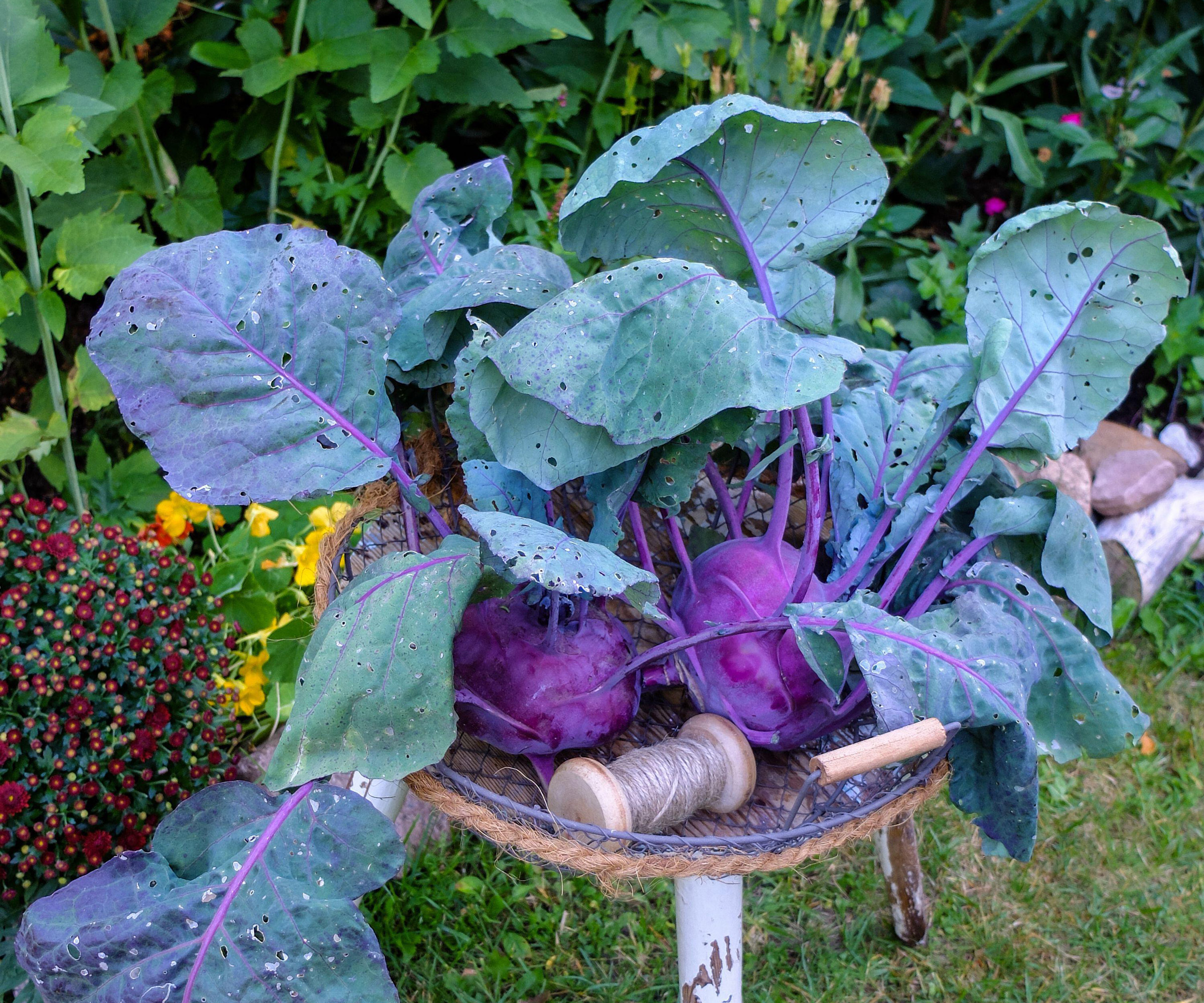
Holes in leaves may be a sign of cabbage whites, but if the problem is tackled in time, your crops are not doomed
Harvesting your kohlrabi
Harvest kohlrabi around 45-60 days - or six to seven weeks - after planting. Nancy Awot-Traut recommends harvesting the stem when the bulb is about 2-3 inches in diameter and the leaves are still young and tender. You can eat both the bulb and the greens (which can be eaten like spinach).
Harvest the stems by cutting at the base with a sharp blade so as not to disturb neighboring plants. Kohlrabi is at its most tender consumed fresh from harvest, although you can keep it in the fridge for a week or two. So while you can store onions, garlic and potatoes for months, you get the best flavors from kohlrabi if you eat straight away. Peel and slice, dice, cube or mash, and enjoy raw or cooked.
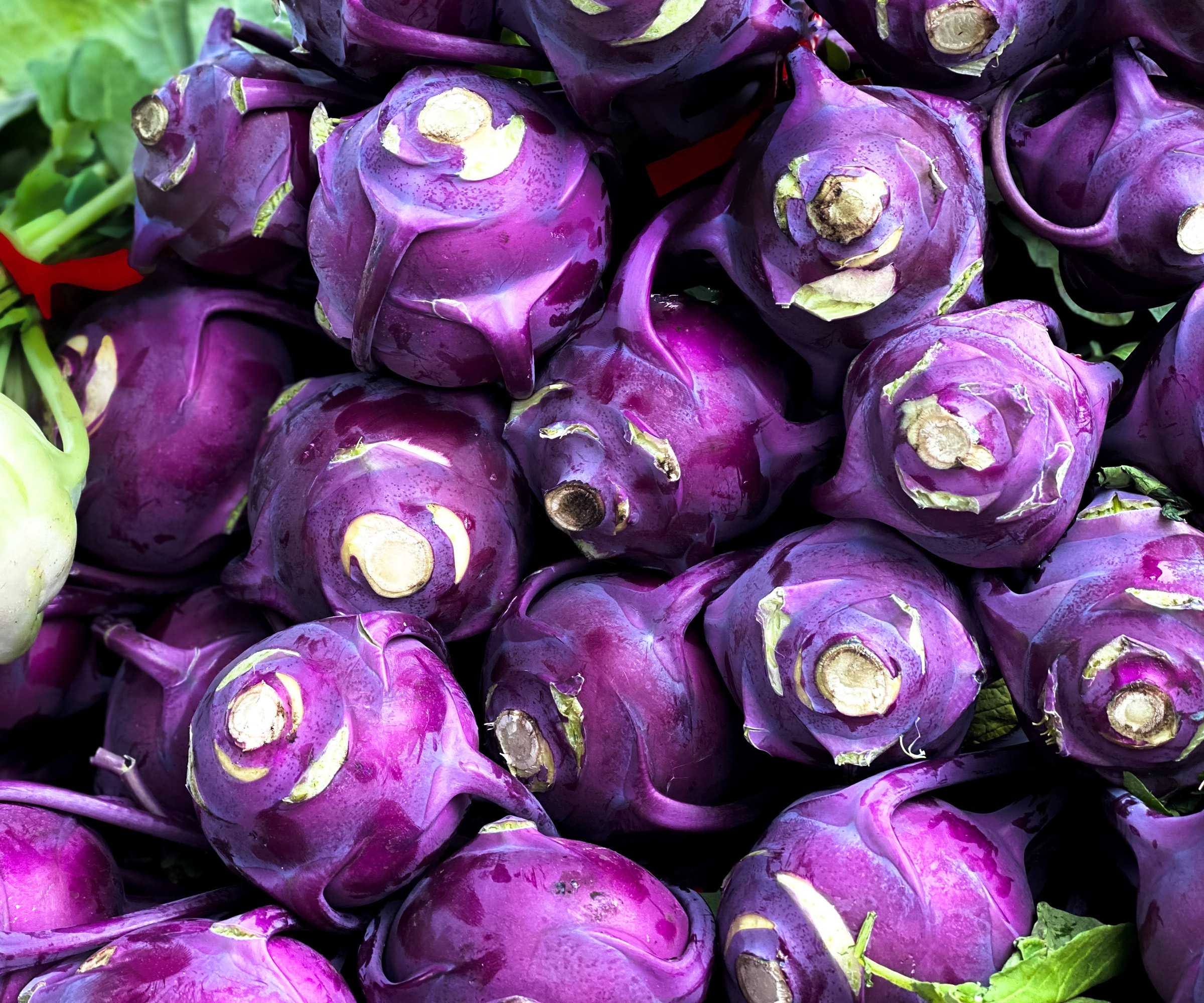
You can harvest kohlrabi as soon as six weeks after planting
FAQs
Why has my kohlrabi not grown a bulb?
If you don’t see the distinctive swollen stem a few weeks after planting, there are a few reasons. 'Usually, this happens when plants are spaced too closely together,' says Burpee’s Nancy Awot-Traut. Make sure they are 6-9in apart, she adds. Crops may also have been exposed to extremes of heat or frost, kept in shade for too long, or deprived of water. When growing kohlrabi, monitor sunshine and moisture levels. If it helps, you can still eat the stems and leaves, even if the bulb does not appear.
Why is my kohlrabi woody and cracked?
When you grow kohlrabi and wind up with woody bulbs, it’s usually because you left crops in the ground too long. Harvest when bulbs are about 2-3in across, says Nancy Awot-Traut from Burpee. It might also be that crops were exposed to hot weather or didn’t get enough water. Even though kohlrabi is an excellent choice for drought-tolerant planting, they can get stressed if neglected, so hydrate well. Cracked bulbs are also a sign of not enough water, or possibly too much nitrogen fertilizer, says Nancy.
Can kohlrabi grow from cuttings?
Assuming you would like to know how to grow kohlrabi from plant cuttings, our advice is: try it, but don’t rely solely on this as your only means of propagation. It is a fun extra option, but growing from seed is generally more reliable and a lot simpler. If you do give it a go, make sure your cuttings have two or three leaves and place in water until you see a root. When this is a few inches long, pot up and place under a cold frame or cloche before hardening off and planting out.
Sign up to the Homes & Gardens newsletter
Design expertise in your inbox – from inspiring decorating ideas and beautiful celebrity homes to practical gardening advice and shopping round-ups.

As assistant editor of Amateur Gardening magazine, Janey's gardening passion was fostered from an early age, when her amazing mum had her deadheading hydrangeas, mulching roses, and propagating strawberry plants from runners for school open days. She's also taken part in lots of conservation and rewilding projects for the RHS and TCV as a way of exploring her horticultural horizons.
-
 Zooey Deschanel and Jonathan Scott's breakfast nook is an innovative, effective use of kitchen space – it turns a 'dead area' into a cafe-style corner
Zooey Deschanel and Jonathan Scott's breakfast nook is an innovative, effective use of kitchen space – it turns a 'dead area' into a cafe-style cornerJonathan and Zooey have situated an eccentric yet elegant dining area in what may have been an otherwise underused corner
By Hannah Ziegler Published
-
 6 things you should never throw in the trash – and what to do for safe disposal instead
6 things you should never throw in the trash – and what to do for safe disposal insteadFrom batteries to space heaters, experts reveal what not to throw
By Andy van Terheyden Published